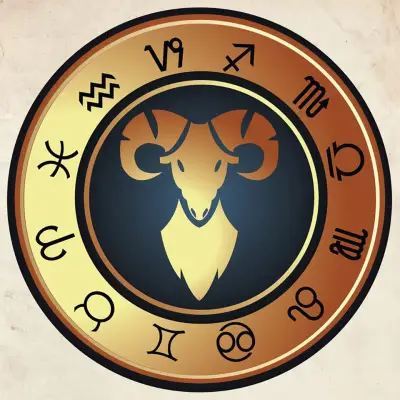When you gaze up at the night sky, it’s hard not to be mesmerised by the twinkling stars that create beautiful patterns above. These patterns, known as constellations, have fascinated humans for centuries. Whether you're a seasoned astronomer or just a curious stargazer, learning about the most famous constellations can deepen your appreciation for the night sky. This guide details some of the major constellations, their shapes, and interesting facts.
Jump to:
- What Are Constellations?
- The Importance of Constellations
- Types of Constellations and Their Characteristics
- Major Constellations
- Cool Constellations with Unique Shapes
- Easy Star Constellations to Spot
- What is the Largest Constellation?
- What is the Smallest Constellation?
- The Brightest Stars in the Sky
- Recognising Constellations: Tips and Tricks
- Common Questions About Constellations
- Study Astronomy for £29
What Are Constellations?

Constellations are groups of stars that form recognisable patterns when viewed from Earth. These patterns often resemble animals, mythological characters, or objects. Ancient civilisations created these patterns to tell stories, navigate, and keep track of the seasons. Today, constellations are still used for navigation and are a favourite subject for astronomers and stargazers alike.
The Importance of Constellations
Constellations serve as a roadmap for the night sky. They help us identify specific stars and celestial objects. Understanding constellations can also enhance your stargazing experience, making it easier to locate planets, meteor showers, and other astronomical events.
Recommended for you!
Best SellersTypes of Constellations and Their Characteristics
Constellations are divided into various types based on their location and visibility:
1. Circumpolar Constellations
These constellations never set below the horizon for a given latitude, making them visible all year round. Examples include Ursa Major and Cassiopeia.
2. Seasonal Constellations
These are visible only during specific times of the year. For instance, Orion is best seen in the winter, while Scorpius is prominent in the summer.
3. Zodiacal Constellations
These are 12 constellations that lie along the ecliptic, the apparent path of the Sun across the sky. They are significant in astrology and include Aries, Taurus, and Gemini.
Major Constellations
Here are some of the most famous constellations that you can easily spot and marvel at their beauty.
1. Orion
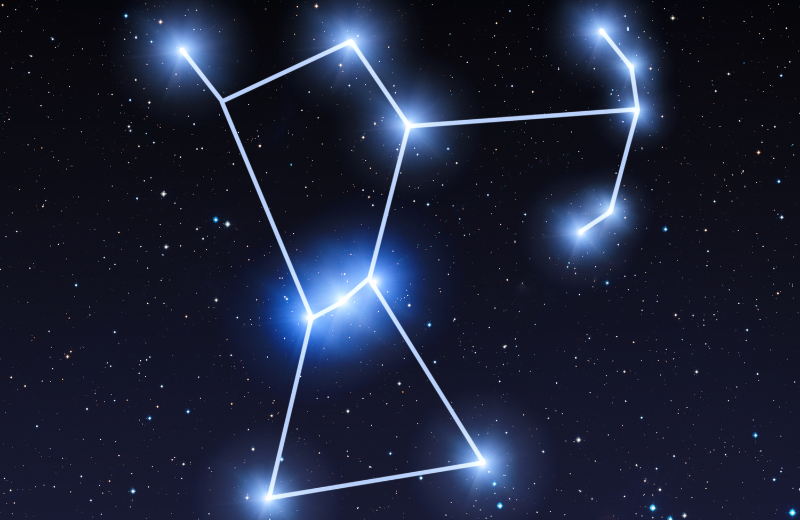
Orion is one of the most recognisable constellations in the night sky. Named after a hunter in Greek mythology, Orion is easy to spot due to its prominent three-star belt. The constellation represents Orion, a giant huntsman whom Zeus placed among the stars.
- Key Stars: Betelgeuse (the brightest star in the constellation), Rigel
- Interesting Fact: Betelgeuse is a red supergiant and one of the largest stars visible to the naked eye. It is so massive that if placed at the centre of our solar system, it would extend beyond the orbit of Mars.
Orion also contains several other notable stars and deep-sky objects, such as the Orion Nebula, a stellar nursery where new stars are born.
2. Ursa Major (The Great Bear)
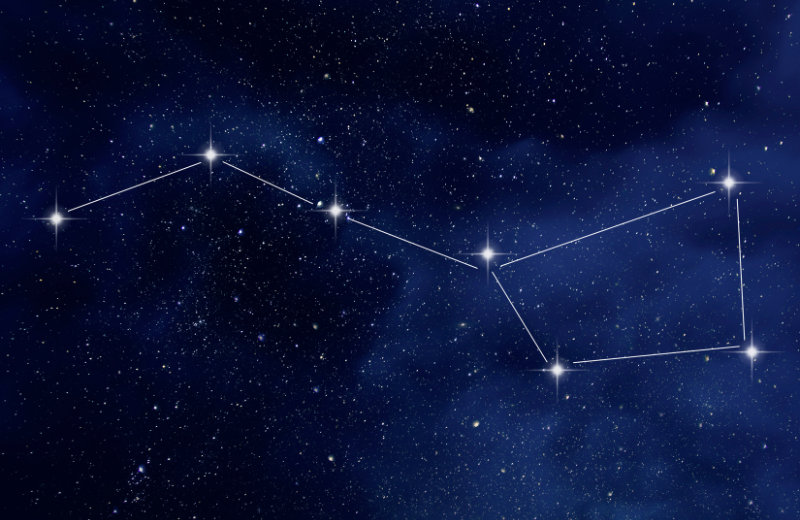
Ursa Major is famous for containing the Big Dipper, a well-known asterism (a smaller pattern within a constellation). This constellation has been recognised since antiquity and is features in various mythologies.
- Key Stars: Dubhe, Merak
- Interesting Fact: The Big Dipper can be used to find the North Star (Polaris), which is part of Ursa Minor. By drawing a line through the two pointer stars, Dubhe and Merak, you can easily locate Polaris.
Ursa Major is also home to several galaxies, including the Pinwheel Galaxy and Bode's Galaxy, making it a favourite target for amateur astronomers.
3. Ursa Minor (The Little Bear)
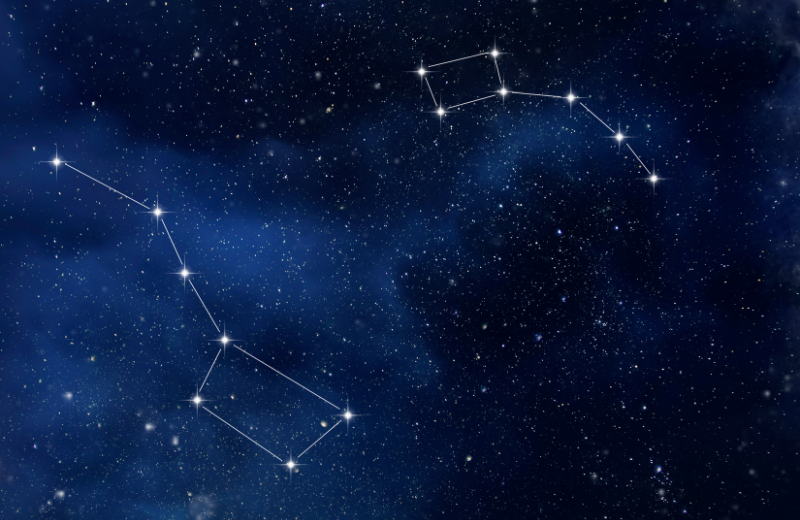
Ursa Minor contains Polaris, the current North Star, making it essential for navigation. This constellation is often depicted as a smaller bear with a long tail, mirroring its larger counterpart, Ursa Major.
- Key Stars: Polaris, Kochab
- Interesting Fact: Polaris is almost directly aligned with the Earth's rotational axis. As a result, it appears almost stationary in the sky, with other stars rotating around it.
Polaris is part of a multiple-star system, with two smaller companion stars orbiting it. This makes it an interesting object of study for astronomers.
4. Cassiopeia
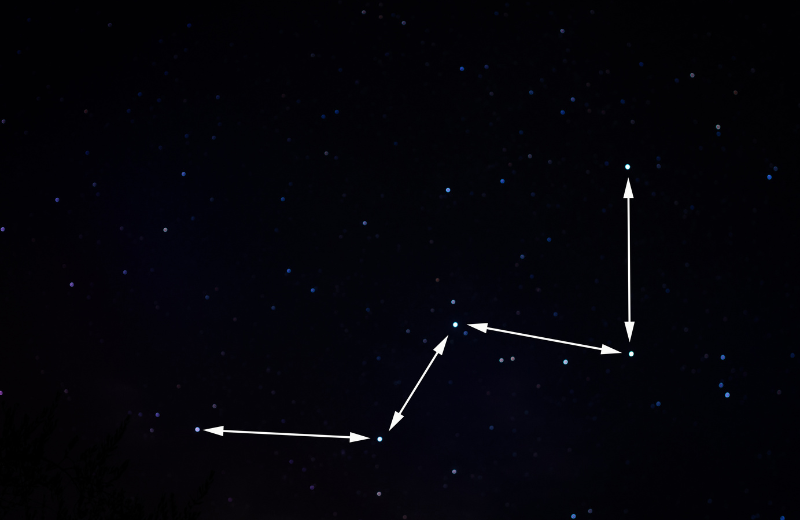
Cassiopeia is easily identifiable by its distinctive 'W' shape formed by five bright stars. According to Greek mythology, Cassiopeia was a queen who boasted about her unrivalled beauty, which led to her being placed in the sky as a constellation.
- Key Stars: Schedar, Caph
- Interesting Fact: Cassiopeia's 'W' shape is actually formed by five major stars that change their positions slightly over time, making it an excellent constellation for studying star movement.
This constellation is located in a rich area of the Milky Way, making it a prime spot for observing star clusters and nebulae, such as the famous Heart and Soul Nebulae.
5. Taurus (The Bull)
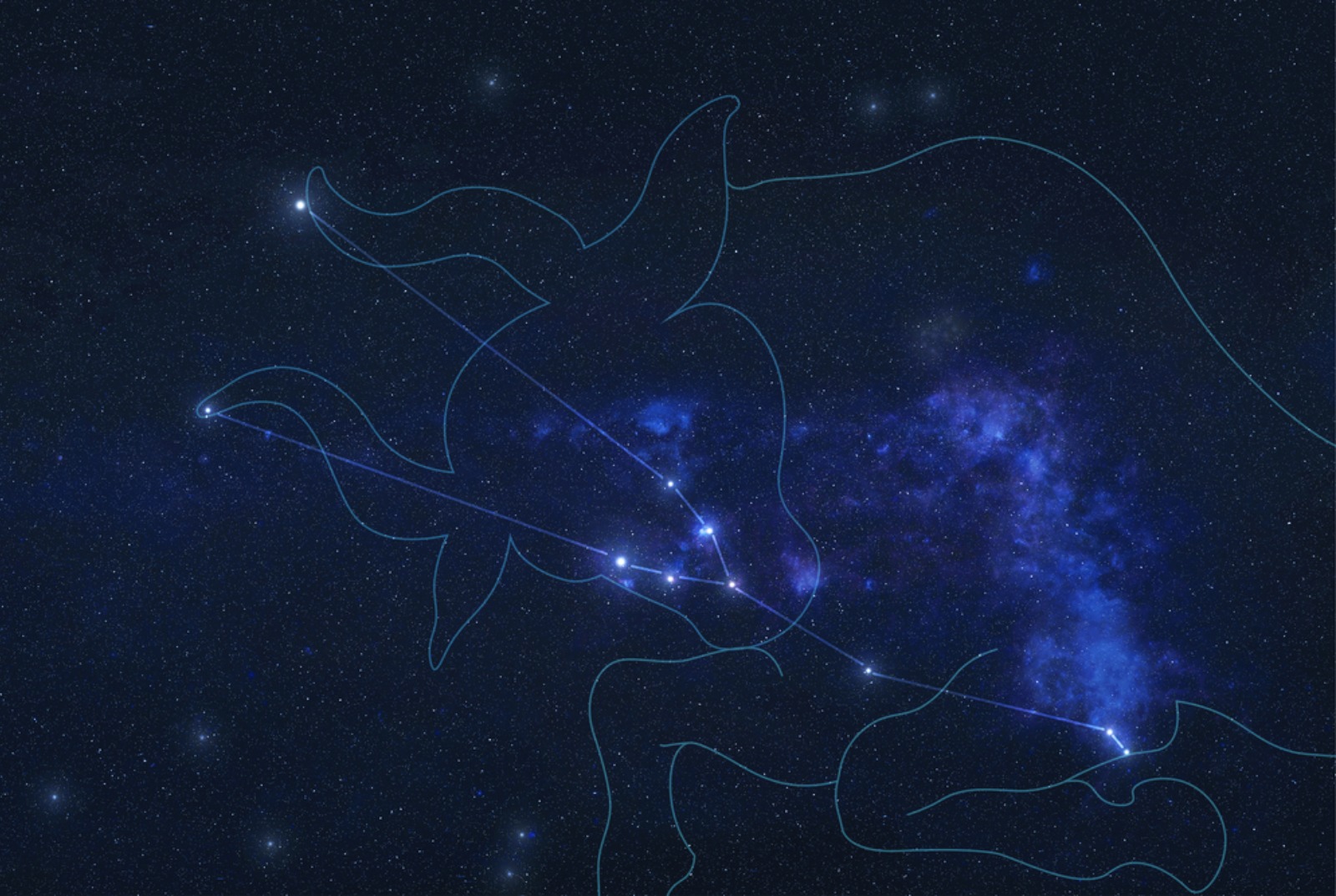
Taurus is another prominent constellation, marked by the bright star Aldebaran and the Pleiades star cluster. This constellation represents a bull and is one of the oldest recognised constellations, dating back to ancient Mesopotamian civilisations.
- Key Stars: Aldebaran, Elnath
- Interesting Fact: The Pleiades, also known as the Seven Sisters, is one of the nearest star clusters to Earth and easily visible to the naked eye. It's a stunning sight and often used in cultural and mythological references.
Aldebaran, the eye of the bull, is an orange giant star that stands out brightly in the night sky. Taurus also contains the Hyades star cluster, another beautiful sight for stargazers.
Cool Constellations with Unique Shapes
Some constellations stand out for their unique and interesting shapes. These constellations often have captivating stories and are a joy to discover in the night sky. Here are a few cool constellations with distinctive forms and fascinating backgrounds.
1. Draco (The Dragon)
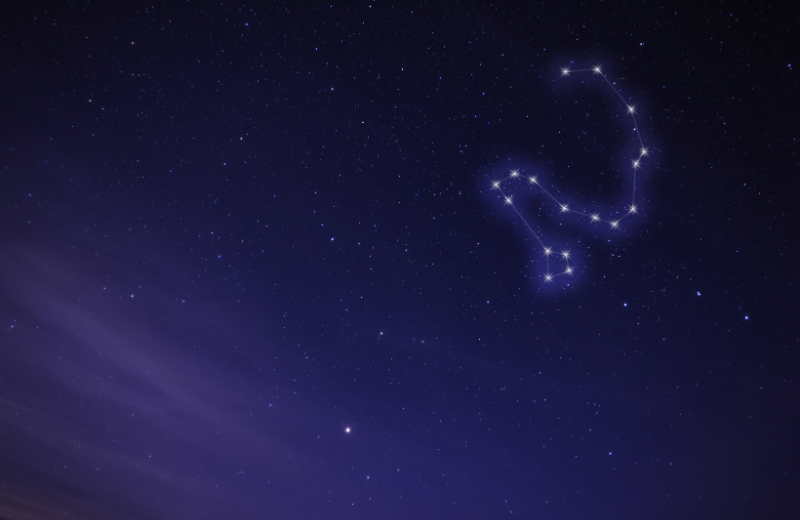
Draco winds its way around the northern sky, resembling a dragon. This long, serpentine constellation is visible all year round in the northern hemisphere.
- Key Stars: Thuban, Eltanin
- Interesting Fact: Thuban was the North Star around 3000 BC due to the precession of the Earth's axis. This historical significance makes Draco an intriguing constellation to study.
Draco contains several notable deep-sky objects, including the Cat’s Eye Nebula, a planetary nebula, and the Spindle Galaxy. Its winding shape and rich history make it a favourite among stargazers.
2. Aquila (The Eagle)
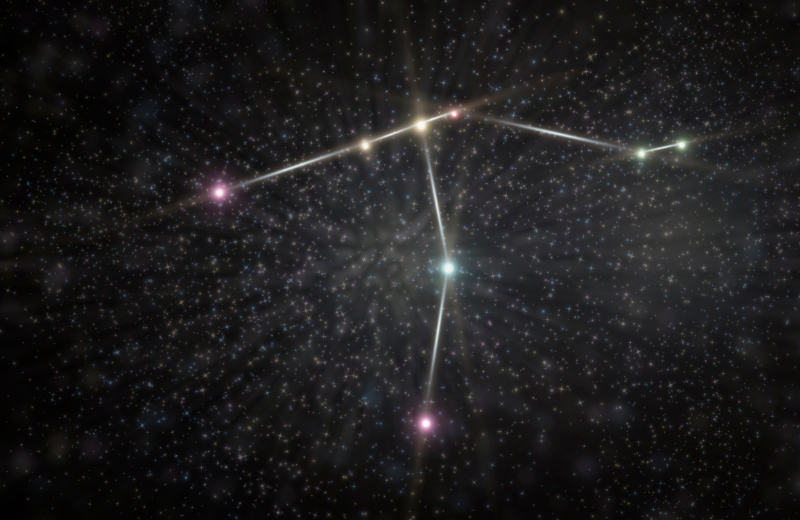
Aquila is known for the bright star Altair, which forms part of the Summer Triangle along with Vega in Lyra and Deneb in Cygnus. Aquila represents the eagle that carried Zeus's thunderbolts in Greek mythology.
- Key Stars: Altair, Tarazed
- Interesting Fact: Altair is only 16.7 light-years away from Earth. It is one of the closest bright stars to our solar system and rotates very rapidly.
Aquila's prominent position in the summer sky and its bright stars make it an easy target for amateur astronomers. The constellation is also rich in mythology, adding to its allure.
3. Phoenix

Phoenix is a southern constellation named after the mythical bird that rises from its ashes. This constellation is visible primarily from the southern hemisphere and is a relatively modern addition to the celestial map.
- Key Stars: Ankaa, Beta Phoenicis
- Interesting Fact: Ankaa means "the Phoenix" in Arabic. This bright star is easy to locate and serves as a guide to finding the rest of the constellation.
Phoenix does not contain many bright stars, but its unique shape and the symbolism of rebirth and renewal make it a fascinating constellation to explore. It also lies in a region of the sky rich with galaxies, providing interesting targets for deeper observation.
4. Sagittarius (The Archer)
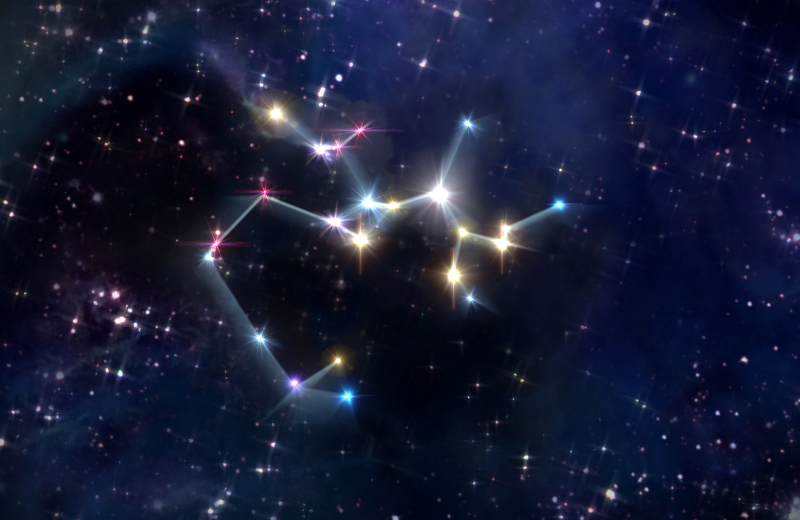
Sagittarius is notable for its distinctive shape, which resembles a teapot. This constellation is rich in celestial wonders and mythology, representing an archer in Greek mythology.
- Key Stars: Kaus Australis, Nunki
- Interesting Fact: The centre of our galaxy, the Milky Way, lies in the direction of Sagittarius, making it a prime location for observing dense star fields and nebulae.
Sagittarius contains several famous deep-sky objects, such as the Lagoon Nebula and the Trifid Nebula. Its location in the sky provides a breathtaking view of the Milky Way during the summer months.
Easy Star Constellations to Spot
Even for those new to stargazing, certain constellations are easy to spot thanks to their bright stars and distinctive shapes. These constellations can be found with minimal equipment, making them perfect for beginners. Here are some of the easiest star constellations to locate and enjoy.
1. Cygnus (The Swan)
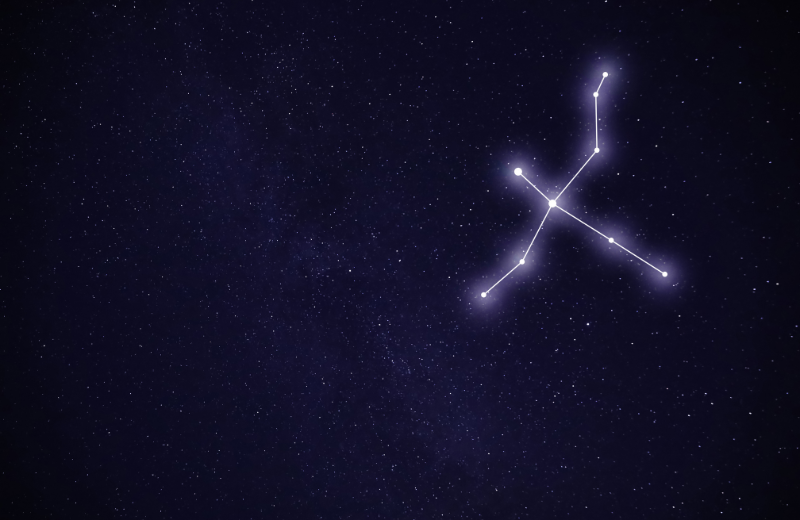
Cygnus is prominent in the summer and looks like a cross, with the bright star Deneb at the tail. This constellation is also known as the Northern Cross due to its cruciform shape.
- Key Stars: Deneb, Albireo
- Interesting Fact: Deneb is one of the brightest stars in the Milky Way. It forms part of the Summer Triangle, a large asterism that helps guide stargazers to other constellations during the summer months.
Cygnus also features Albireo, a beautiful double star with contrasting colours. Observing Albireo through a telescope reveals a stunning blue and gold pair of stars, a favourite target for amateur astronomers.
2. Lyra (The Lyre)
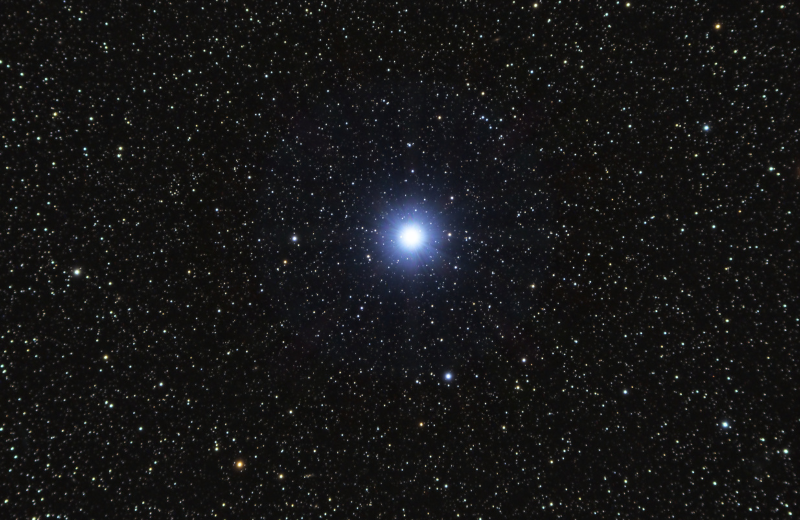
Lyra contains Vega, one of the brightest stars in the night sky and part of the Summer Triangle asterism. The constellation is small but easy to locate due to Vega’s brilliance.
- Key Stars: Vega, Sheliak
- Interesting Fact: Vega is about 25 light-years from Earth and was the first star other than the Sun to be photographed. It has been extensively studied and serves as a reference point for calibrating telescopes.
Lyra is also home to the famous Ring Nebula (M57), a planetary nebula that appears as a small, smoke-ring-like object through a telescope. This makes Lyra a fascinating constellation for those interested in deep-sky objects.
3. Canis Major (The Great Dog)
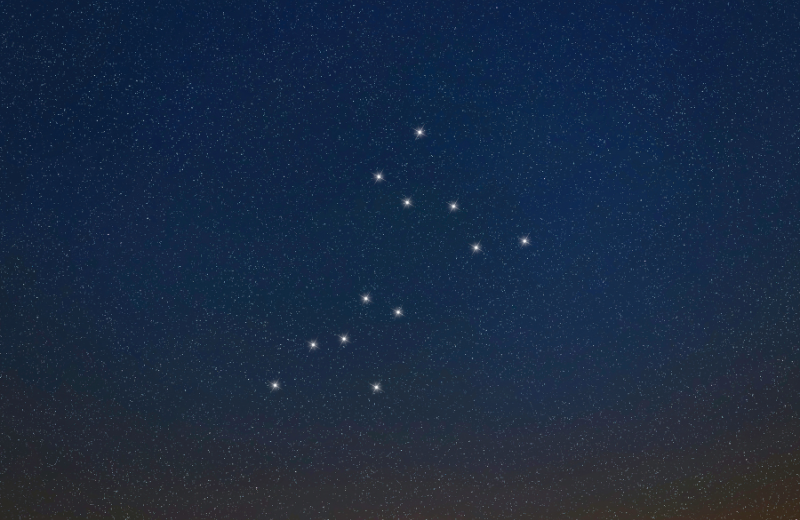
Canis Major is home to Sirius, the brightest star in the night sky. This constellation is easy to find during the winter months, following the constellation of Orion.
- Key Stars: Sirius, Adhara
- Interesting Fact: Sirius is often called the Dog Star and is twice as bright as any other star in the sky. Its intense brightness and proximity to Earth (just 8.6 light-years away) make it a prominent feature of the winter sky.
Canis Major also contains other notable stars like Adhara, a bright binary star system. The constellation itself is associated with the mythological hunting dogs of Orion, adding a layer of narrative interest to your stargazing.
4. Crux (The Southern Cross)
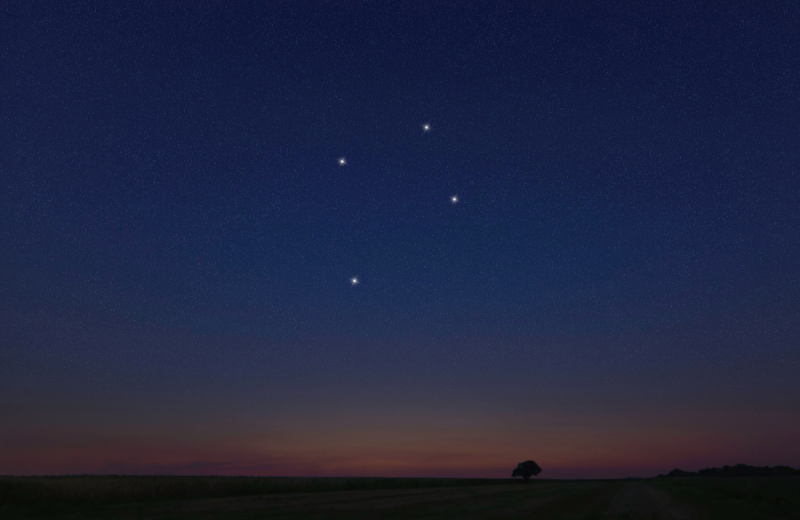
Crux, also known as the Southern Cross, is a small but easily recognisable constellation in the southern hemisphere. Its distinctive cross shape makes it a symbol of the southern skies.
- Key Stars: Acrux, Mimosa
- Interesting Fact: Despite its small size, Crux is a vital navigation tool for southern hemisphere stargazers, helping to find the south celestial pole.
Crux also features the Jewel Box cluster, a bright open cluster of stars that appear like a box of sparkling jewels through a telescope.
5. Leo (The Lion)
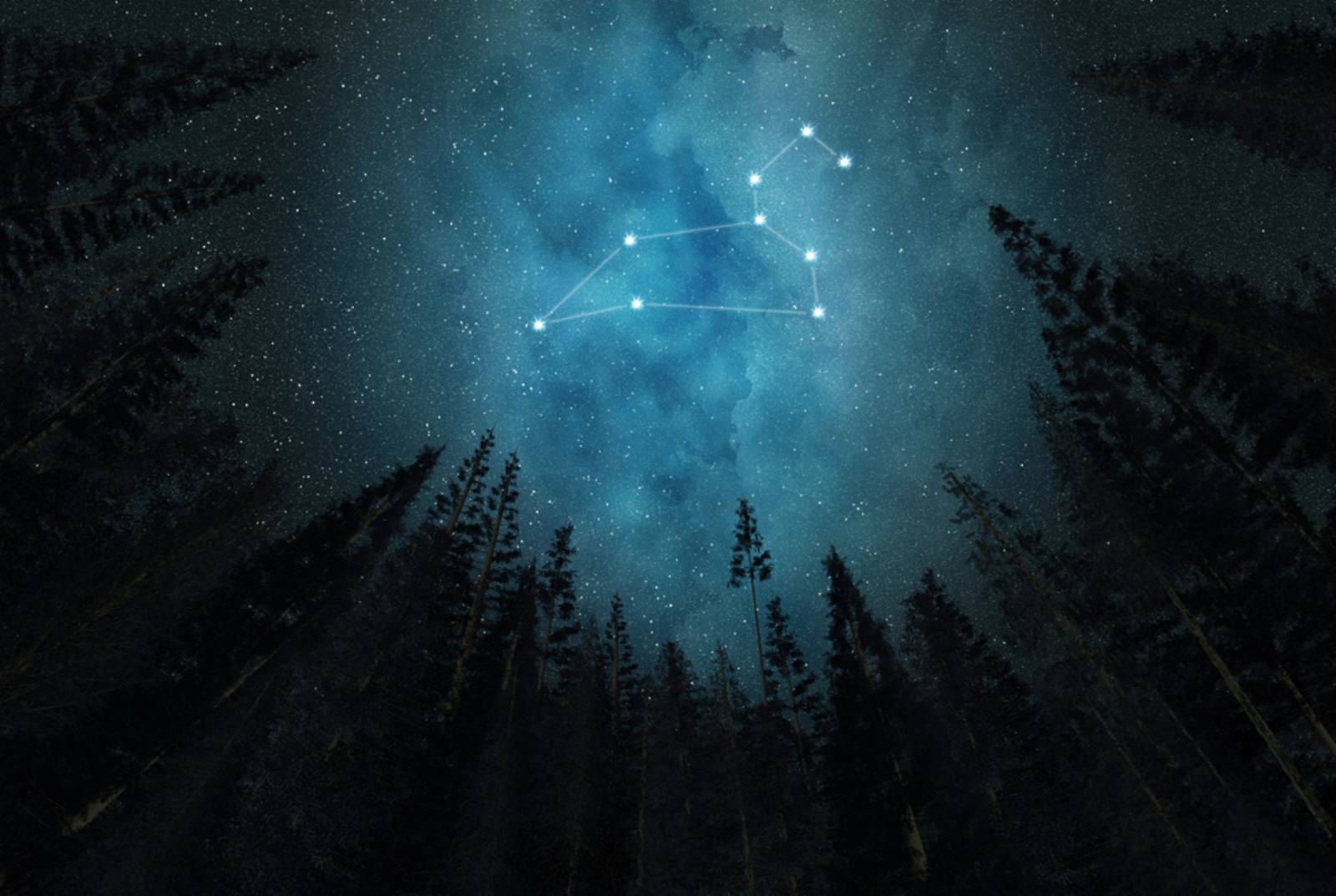
Leo is easy to spot thanks to its backward question mark shape, known as the Sickle, which forms the lion’s head. This constellation is best seen in the spring.
- Key Stars: Regulus, Denebola
- Interesting Fact: Regulus, the brightest star in Leo, is actually a four-star system, adding an intriguing complexity to this already fascinating constellation.
Leo is home to several bright galaxies, including the Leo Triplet, making it a target-rich environment for amateur astronomers interested in deep-sky objects.
What is the Largest Constellation?
The largest constellation is Hydra. Spanning over 3% of the sky, Hydra is a long, winding constellation that resembles a serpent. Its vast expanse and serpentine shape make it a prominent feature in the celestial sphere.
What is the Smallest Constellation?
The smallest constellation is Crux, also known as the Southern Cross. Despite its small size, Crux is easily recognisable and holds significant importance in the southern hemisphere. Its distinctive cross shape makes it an iconic and easily spotted constellation in the night sky.
The Brightest Stars in the Sky
The night sky is home to many brilliant and bright stars. Here are the brightest stars in the sky, each with its unique characteristics and historical significance.
1. Sirius
Sirius, found in the constellation Canis Major, is the brightest star in the night sky. It’s often referred to as the Dog Star due to its prominent position in the Great Dog constellation. Sirius is a binary star system, consisting of a white main-sequence star (Sirius A) and a faint white dwarf companion (Sirius B). Its brilliance and proximity to Earth, at just 8.6 light-years away, make it a key feature in the winter sky.
2. Canopus
Canopus is the second-brightest star and is located in the constellation Carina. This star is more prominent in the southern hemisphere and serves as a vital navigation star for those in the southern latitudes. Canopus is a giant star, significantly larger and more luminous than our Sun, situated about 310 light-years from Earth. Its importance extends to various cultures and historical navigation practices, particularly for its role in guiding sailors.
3. Alpha Centauri
Alpha Centauri is part of the Centaurus constellation and is the closest star system to our solar system, lying just over 4 light-years away. This system is a triple star system, comprising three stars: Alpha Centauri A, Alpha Centauri B, and Proxima Centauri. Proxima Centauri, the third component, is the closest individual star to our Sun and has been the focus of many studies due to its proximity and potential for hosting exoplanets.
4. Arcturus
Arcturus, located in the constellation Boötes, is the fourth-brightest star in the night sky and the brightest star in the northern celestial hemisphere. This red giant star is approximately 37 light-years from Earth and is notable for its high velocity relative to our solar system. Arcturus has been revered in many cultures and is often used as a reference point for amateur astronomers due to its distinct orange hue and brightness.
5. Vega
Vega, a star in the constellation Lyra, is the fifth-brightest star in the night sky and one of the key stars in the Summer Triangle asterism. Vega is about 25 light-years from Earth and was the first star other than the Sun to be photographed and have its spectrum recorded. Its relatively close distance and brightness make it a significant star for astronomical studies and a focal point for understanding stellar properties and evolution.
Recognising Constellations: Tips and Tricks
Recognising constellations can enhance your stargazing experience by helping you navigate the night sky more effectively. Here are some practical tips and tricks to help you identify constellations and deepen your understanding of the stars above.
1. Use a Star Chart
A star chart is a map of the night sky that shows the positions of stars and constellations at a specific time and location. It’s an invaluable tool for beginners, as it helps you learn the layout of the sky and locate various celestial objects. Star charts can be found in astronomy books, online, or as part of stargazing kits. By familiarising yourself with a star chart, you can easily identify major constellations and track the movement of stars across different seasons.
2. Download an App
In the digital age, there are many apps available that use your phone’s GPS to show you which constellations are visible from your location in real time. These apps often come with interactive features, such as augmented reality, which overlay constellation patterns onto your phone’s camera view of the night sky. Popular stargazing apps include SkyView, Star Walk, and Stellarium Mobile. These tools make it easy for anyone to find and identify constellations with just a few taps, making stargazing more accessible and enjoyable.
3. Join a Stargazing Group
Local astronomy clubs often organise stargazing events where experienced members can help you identify constellations. Joining a stargazing group provides a supportive community of enthusiasts who share your interest in the night sky. These groups frequently host events at locations with minimal light pollution, allowing for clearer views of the stars. By participating in these gatherings, you can learn from seasoned astronomers, use high-quality telescopes, and gain hands-on experience in recognising constellations and other celestial phenomena.
4. Study an Astronomy Course
For a more in-depth understanding of the night sky, consider enrolling in an astronomy course. Centre of Excellence offers an Astronomy Diploma Course that provides fascinating knowledge about stars, constellations, and other celestial phenomena. For a limited time, you can access this course for just £29.
Common Questions About Constellations
What are the 7 most famous constellations?
The seven most famous constellations are Orion, Ursa Major, Ursa Minor, Cassiopeia, Taurus, Scorpius, and Leo. These constellations are well-known due to their bright stars and distinctive shapes, making them relatively easy to identify in the night sky.
What is the most recognisable constellation?
Orion is generally considered the most recognisable constellation due to its distinct shape and bright stars, such as Betelgeuse and Rigel. The three stars that form Orion’s Belt make it easy to identify, even for novice stargazers.
What is the hardest constellation to find?
Many people find Camelopardalis, a faint constellation representing a giraffe, challenging to locate due to its lack of bright stars. Located near the north celestial pole, Camelopardalis requires a dark sky and good star maps to identify.
Which constellations are always visible?
Certain constellations are always visible throughout the year from specific latitudes. These are known as circumpolar constellations. For example, in the northern hemisphere, Ursa Major, Ursa Minor, Cassiopeia, Draco, and Cepheus are always visible because they circle around the North Star, Polaris.
What is the rarest constellation?
One of the rarest constellations is Equuleus, the Little Horse. It is the second smallest constellation and lacks bright stars, making it difficult to spot and often overlooked.
What is the most beautiful constellation?
Beauty is subjective, but many consider Orion to be the most beautiful constellation due to its bright stars and striking arrangement. The Orion Nebula, a region of star formation within the constellation, adds to its visual appeal.
What are the top 10 biggest constellations?
The top 10 biggest constellations by area are Hydra, Virgo, Ursa Major, Cetus, Hercules, Eridanus, Pegasus, Draco, Centaurus, and Aquarius. These constellations cover large portions of the sky and contain numerous stars and deep-sky objects.
What is the least famous constellation?
One of the least famous constellations is Antlia, the Air Pump. It is faint and does not have any particularly bright stars or notable deep-sky objects, making it less well-known among stargazers.
Which constellation is the most difficult to pronounce?
The constellation Camelopardalis, named after the giraffe, is often cited as one of the most difficult to pronounce due to its length and unusual name.
Are there any constellations that no longer exist?
While all historically recognised constellations still exist, some asterisms (smaller star patterns within constellations) and old constellations are no longer officially recognised by the International Astronomical Union (IAU). For example, Quadrans Muralis, which used to be a constellation, is now part of Boötes.
What are some uncommon constellations?
Uncommon constellations include Vulpecula (the Little Fox), Monoceros (the Unicorn), and Lacerta (the Lizard). These constellations are faint and less frequently observed, making them less familiar to many stargazers.
Recommended for you!
Best SellersStudy Astronomy for £29
If you've enjoyed learning about constellations and want to delve deeper into the wonders of the night sky, consider enrolling in our Astronomy Diploma Course at Centre of Excellence. For a limited time, the course is available for just £29.

